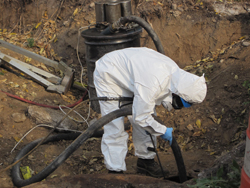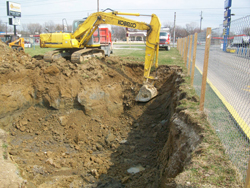Drycleaners and TCE Sites
Drycleaning sites can pose some unique problems in site characterization work. Drycleaning solvents have diverse properties that control their fate and transport in the subsurface. At some sites, both chlorinated and petroleum solvents have been used. PCE, TCE, carbon tetrachloride, TCA, and Freon 113 are dense non-aqueous phase liquids (DNAPLs), and petroleum drycleaning solvents are light non-aqueous phase liquids (LNAPLs). Although these are well known facts, the experience of environmental consulting has been dominated by work on LNAPL sites, particularly work associated with petroleum storage tanks.
There is a strong tendency among many environmental consulting firms to approach site assessment work at dry cleaning sites in the same manner as petroleum sites. The chlorinated drycleaning solvents are DNAPLs and will sink in the aquifer, concentrating above the lower permeability zones in the aquifer. Collection of deeper groundwater samples very often results in finding groundwater contaminant levels several orders of magnitude higher than cleanup target levels. All of this may seem very fundamental, but a number of site assessments conducted at drycleaning sites have utilized only monitor wells screened across the water table and perhaps one deeper monitor well, that very often has been installed up-gradient of the contaminant source area.
Drycleaner Environmental Assessment
The key to a successful site assessment is preparation. Preliminary site assessment work involves a review of existing data including a desk-top review, and site reconnaissance.
Objectives of the preliminary assessment phase:
- Identification of potential contaminant point sources and environmental concerns at the site
- Identification, in a preliminary manner, of the subsurface conditions at and near the site vicinity to develop a site conceptual model
- Establishment of a framework for subsequent site investigation work
Where to Sample
In general, sampling to delineate contaminant source areas should occur in areas where solvents were transferred, stored, and used and where solvent wastes were stored and disposed. Samples should be collected in the vicinity of the following:
- Drycleaning Machines
- Distillation Unit
- Service Door
- Sanitary Sewer - Septic Tank/Drain Field
- Floor Drains
- ASTs/USTs
- Storm Sewers
- Dumpsters/Trash Cans
- Blind Drains
- Storage Buildings













